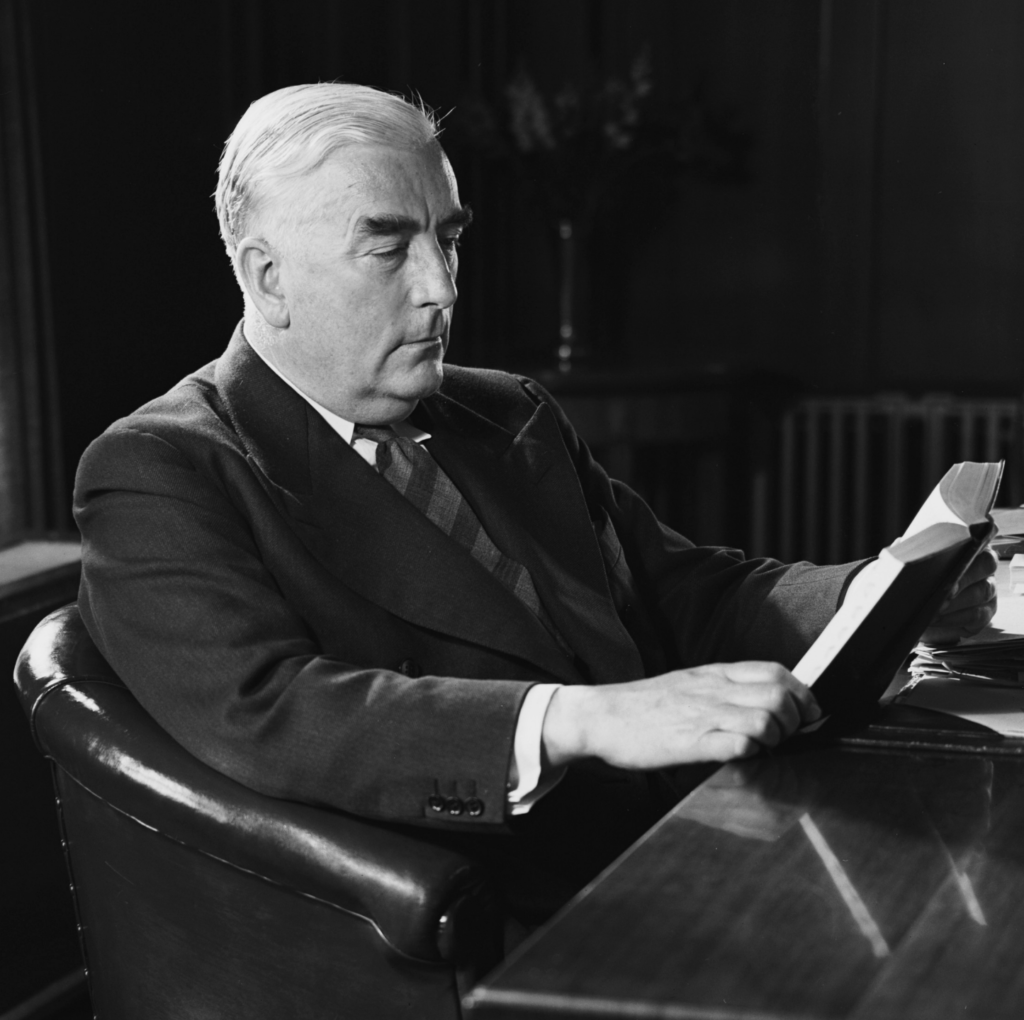Sir Robert Menzies, the former and longest serving Prime Minister of Australia (1939-1941; 1949 – 1966) amassed a collection in excess of 4500 books over the span of his life. Housed at the Baillieu Library and put on display at the Robert Menzies Institute Museum in the Old Quad at the University of Melbourne, Menzies’s personal library stands as one of the most historically significant collections in Australia.
Sir Robert had a deep connection with higher education and in particular with the University of Melbourne throughout his life as a former student (1913 – 1918) and later Chancellor (1967 – 1972). In 1976 he donated his personal library to the University in the hope that it would become a reference library to be utilised by academics and students. In line with his wishes, the collection was installed into the Leigh Scott Room in the Baillieu Library at the University of Melbourne in 1980, where it remains today.
It is both a personal library and a working one: it includes gifts from family members and friends as well as material relating to Menzies’s student years, and his professional years as a barrister, Prime Minister and Chancellor of the University of Melbourne. It spans his life from schooldays to retirement. The material contained includes photo albums, handwritten notebooks as well as collected papers and books on subjects ranging from politics, literature, poetry, history, religion, art, comedy, architecture, to cricket. The collection also includes books belonging to Robert’s father James Menzies, his wife Dame Pattie Menzies and other family members.
The collection is a unique historical and cultural artefact, showcasing the breadth of Menzies’s intellectual influences and acting as a sociological time capsule of 20th century Australia. There are fascinating stories behind many of the works which have made its way onto his shelf, from his early prize-winning years in the small rural town of Jeparit to his later years where life-long admirers, prominent world figures and dear friends would send the great statesman their latest works.
Unlike many grand libraries of a similar calibre, Sir Robert’s collection is not a “collector’s library” but a personal one. A unique and striking feature of the collection is that as a keen and voracious reader, Sir Robert regularly engaged with his texts at length. His books are full of annotations, highlights and earmarked pages. Additional historical value in the collection can also be derived from many enclosed letters, original drawings, photos and inscriptions from countless leading global figures from the Dalai Lama to John F. Kennedy. There is abundance of primary resource material within the works and it for this reason rightfully used for research as well as treasured and displayed within our museum.
Approximately one-third of the volumes in the collection were gifts to Sir Robert by many important figures involved in his professional and personal life. The inscriptions include those made by heads of state and government, artists, authors, intellectuals, cricketers, journalists and otherwise notable contemporaries. The inscriptions often reflect the feelings of the donor on Sir Robert’s influence on them and his contribution in shared endeavours in national and world events. Menzies was meticulous with acknowledging the date of receipt of his books, so researchers can also gain an insight as to when the work made its way into the collection.
Amongst the many intimate and unique items related to Sir Robert, highlights include everything from university lecture notes from Melbourne University, personal photo albums from his major trips abroad, confidential letters sent to senior ministers at the height of the Suez crisis, as well as an extensive collection of his poetic works from his early years.
The display of the collection in the Leigh Scott Room is intact and organised to replicate as closely as possible Sir Robert’s thematic and subject organisation of his library. Correspondence provided at the time of the bequest included a schema prepared by Sir Robert’s Personal Secretary, Ms Hazel Craig, that confirmed Sir Robert’s organisation of his library to make it useful to him.
The collection should be viewed as a single collection comprising many individual items, an artefact of Sir Robert’s thought and intellectual framework in using books as a basis for learning, stimulation, and relaxation. Viewing the collection as a single entity reveals the themes and subjects that were important to Sir Robert in his professional life in the law and politics, and his other intellectual and relaxation interests.
It is one of very few personal libraries of such a significant national and international figure which as a condition of the bequest has remained intact in one location and is a personalised artefact of the collector’s life and interests at the time of its bequest to the University of Melbourne. It is perhaps most like the collection of Thomas Jefferson’s Library, prominently displayed in the Library of Congress in Washington DC.
That collection is valued and utilised as a snapshot of not only Jefferson’s intellectual influences, but also his intellectual context; how western thought had developed by the late 18th and early 19th centuries. Similarly, the Menzies collection has great potential to reveal much about not only Menzies but the Australian cultural landscape of the 20th century.
The Robert Menzies Institute showcases a revolving display of these unique items in the Old Quad at the University of Melbourne and welcome the opportunity to provide personalised tours from 10am – 2pm on Monday – Thursday.
The Collection, including scanned images of inscriptions and annotation can be viewed online or accessed in person at the Baillieu Library. For viewing specific items in the collection, please make an appointment in the Reading Room in the Baillieu Library at the University of Melbourne.
Sign up to our newsletter
Sign up for our monthly newsletter to hear the latest news and receive information about upcoming events.


